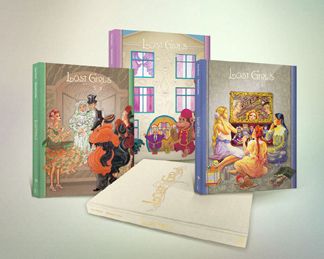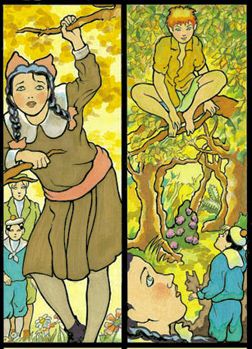COMICS: A sneak peek at Alan Moore's "Lost Girls"
There's rarely a consensus when it comes to creativity, but ask comic book fans who the greatest writer of modern times is and one name will keep popping up again and again – Alan Moore. His library of comic work is legendary – Watchmen, V For Vendetta, Swamp Thing, Tom Strong, League of Extraordinary Gentlemen, From Hell and many more. Few have combined so well the traditions of fine literature with the conventions of comics, and fewer still have strained the borders of the comic panel like Moore and his collaborators. Again and again, Moore has pushed comics to be more than many thought they could be, tackling race, power, mythology and politics.
 Now, in his latest, the massive magnum opus Lost Girls drawn by his fiancee Melinda Gebbie, Moore zeroes in on one topic guaranteed to draw eyeballs in – sex.
Now, in his latest, the massive magnum opus Lost Girls drawn by his fiancee Melinda Gebbie, Moore zeroes in on one topic guaranteed to draw eyeballs in – sex. Lost Girls is a tremendous project, a set of three elaborately designed, oversized 112-page hardcover volumes to be published by Top Shelf Productions next month. It could scarcely be more designed to get attention, because in his sweeping examination of sex, lust and desire, Moore appropriates three of children's literature's most beloved heroines – from Alice in Wonderland, a grown-up, middle-aged Alice; from Peter Pan, the girl Wendy now a buttoned-up married woman; and from Wizard Of Oz, a sexed-up young adult Dorothy Gale.
Dorothy at an orgy? Oh no! Yet Lost Girls is an elegant, important work, miles away from the "Tijuana Bible" porn comics. At $75 for its entirety, it's also clearly not aimed at casual browsers. But, having read a preview copy, I can say it's without doubt one of the year's finest graphic novels – finest books, period.
It's a project Moore and Gebbie have been working on for nearly 20 years. Moore uses the "awakenings" each of the traditional stories contained and retells them in sexual terms (you can only imagine what the Tin Man and Scarecrow get up to with Dorothy, for instance). Yet slightly blasphemous as the notion seems, Moore is respectful to these characters in his way. "We didn't want to do something that was a sniggering parody of those works," he said in a recent interview. Lost Girls tells the tale of these three girls meeting in 1913, long after their famous adventures, at a strange private resort in France. The women are gradually drawn into each others' orbit, despite their very different personalities, and, instigated by the authoritative, debauched Alice, ascend into their own private universe of never-ending sensuality and dreams. As history is revealed, sex becomes more and more expansive, swelling up and flooding their everyday lives.
Read in one sitting, the three volumes of Lost Girls are a bit overwhelming, a constant parade of flesh-filled erotica and ever-escalating acts of desire. Like watching a lengthy porn movie, you get desensitized to it and start seeing perpetual nudity and sex as almost normal. It works far better read chapter by chapter, with pauses in between to reflect a little on what Moore and Gebbie are saying.
 All but the most worldly of readers will likely be astonished by how graphic Lost Girls is. As the tale unspools, Moore takes his characters into ever-more-elaborate pageants of pornography, from group sex to homosexuality and even, perhaps most troubling, incest and child sex. Yet this is ultimately non-exploitive porn with a soul, steeped in literary tradition, hearkening back to the legendary (and still shocking) work of the Marquis de Sade. Moore stands firmly on the belief that a fiction is a fiction, and cannot be held complicit for events in reality. "Pornographies are the enchanted parklands where the most secret and vulnerable of all our many selves can safely play," one character says. Lost Girls is id run amok, unapologetic.
All but the most worldly of readers will likely be astonished by how graphic Lost Girls is. As the tale unspools, Moore takes his characters into ever-more-elaborate pageants of pornography, from group sex to homosexuality and even, perhaps most troubling, incest and child sex. Yet this is ultimately non-exploitive porn with a soul, steeped in literary tradition, hearkening back to the legendary (and still shocking) work of the Marquis de Sade. Moore stands firmly on the belief that a fiction is a fiction, and cannot be held complicit for events in reality. "Pornographies are the enchanted parklands where the most secret and vulnerable of all our many selves can safely play," one character says. Lost Girls is id run amok, unapologetic. Moore's work has grown in complexity and layers since his more mainstream material – his prose novel Voice of The Fire is almost Joycean in its cycling themes and references. Ditto his recent comic series Promethea, which moved from standard superheroine action into something quite magical and immense. Lost Girls is another step in the odyssey of this literary genius – a word I do not use lightly.
Moore gets us to think about the very nature of pornography. The very word itself has become a negative thing, largely because so much porn is hateful or merely artless. Yet by applying the full bore of his considerable talents upon the art of procreation, Moore reminds us that sex can be art. Very little porn out there is these days, but once upon a time, erotic fiction was a distinct, credible genre. Lost Girls is Alan Moore's most revolutionary work, designed to smash assumptions, crash barricades.
In a remarkable three-part interview at the Web site Comic Book Resources with writer Adi Tantimedh, Moore lays bare some of his motivations for what will be seen by some as a red flag in the culture wars: "Whatever urges there are out there are in our sexual imagination. And it seems to me that is a thing we fail to explore at our peril, if we allow shadowy, unexpected corners of it to remain where it is and never look inside them, and we end up with pretty much the type of society we've got now, where there is a fanatic outcry at anything suggestive involving a child where there is complete apathy at the number of children who are blown up every day in the world's war zones. Yeah, they only had their limbs blown off, but they haven't been touched sexually. That is something that is worth looking at."
 Much of Moore's work involves a critical transformative event that breaks the border between worlds, such as the genocidal concentration camp that creates his "V" in V For Vendetta, or the murders of Jack the Ripper seen as a kind of invocation for the 20th century in From Hell. In Lost Girls, the telling of sexual histories by his girls is a chance for them to escape old hurts, embrace old pains and enjoy their sexuality unashamed. Wendy, from Peter Pan, is a tightly wound Victorian prude when we first see her, but gradually opens to embrace her lusty past with Moore's sexaholic Pan. Alice went "through the looking glass" to a terrible world where she was used and abused by others, only finally emerging with her own self-identity and pleasures. It certainly helps reading Lost Girls to be familiar with Oz, Pan and Alice, but even if you haven't read the original books many of their broad storylines are still familiar to us all.
Much of Moore's work involves a critical transformative event that breaks the border between worlds, such as the genocidal concentration camp that creates his "V" in V For Vendetta, or the murders of Jack the Ripper seen as a kind of invocation for the 20th century in From Hell. In Lost Girls, the telling of sexual histories by his girls is a chance for them to escape old hurts, embrace old pains and enjoy their sexuality unashamed. Wendy, from Peter Pan, is a tightly wound Victorian prude when we first see her, but gradually opens to embrace her lusty past with Moore's sexaholic Pan. Alice went "through the looking glass" to a terrible world where she was used and abused by others, only finally emerging with her own self-identity and pleasures. It certainly helps reading Lost Girls to be familiar with Oz, Pan and Alice, but even if you haven't read the original books many of their broad storylines are still familiar to us all. Ultimately, Lost Girls is about whether we embrace violence or its gentler alternatives, our good or bad natures. There's a firm anti-war message wrapped up in the gaudy fantasia, as the grim events of World War I loom over and ultimately consume the three women's private paradise.
I've concentrated heavily on Moore's writing here because it's so commanding and confident, but I don't want to slight Melinda Gebbie's artwork. Moore's partner is an integral part of Lost Girls, and her beautiful artwork brings it to unforgettable life. Gebbie's gauzy, vaguely fairy tale-like style blends well with Moore's tale of self-exploration. It's also subtly versatile -- flipping through pages, you can really see how Gebbie tightens or loosens her style according to the demands of the tale. The colors are particularly gorgeous, done by hand without digital manipulation. Her style evokes an older era, yet has a modern tint. And her very presence as a muse for Moore's tale defeats any argument that Lost Girls is sexist – a ridiculous assault, as Lost Girls is far more told from the female point of view than male.
I'll be curious to see if upon its August release Lost Girls becomes another rallying cry for some conservatives, and causes outrage among those who aren't even going to read it. It would be a shame – in this very bold, very human saga, Moore has created a thesis on sexuality that stands with his finest work.

No comments:
Post a Comment